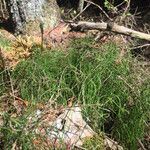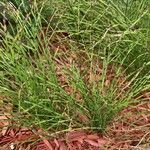Stems all alike, evergreen, prostrate or ascending, often bent or contorted, 0.7–2.5 dm, 0.5–1 mm thick, unbranched or with a few long branches, with 3 primary ridges, the ridges tuberculate, broadly and deeply concave, so that the stem appears 6-ridged; central cavity none, vallecular cavities 3, large; stomates in 2 rows in each principal furrow; sheaths 3–4 mm, flaring, with a broad black band above a usually green base, the 3 scarious-margined teeth each with a subulate, often deciduous tip; cones small, 3–5 mm, subsessile, apiculate. Moist, often swampy places, especially in coniferous woods; circumboreal, in Amer. s. to Conn., N.Y., s. Ill., Io., S.D., and Wash.
Aerial stems persisting more than a year, unbranched, tortuous, 2.5--28 cm; lines of stomates single; ridges 6. Sheaths green proximally, black distally, elliptic in face view, 1--2.5 × 0.75--1.5 mm; teeth 3, dark with white margins, not articulate to sheath. Cone apex pointed; spores green, spheric. 2 n =216.
A herb.



